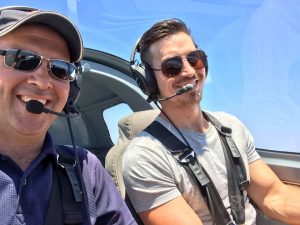CTAF stands for Common Traffic Advisory Frequency. This radio frequency is used for non-controlled (or Class G) aerodromes or airports at which the control tower closes overnight.
Here is a list of Caloundra CTAF Radio Calls in printable PDF form.
You must follow the Basic Radio rules as per the CASA website. A broadcast (CAR 166C) must include:
- the name of the aerodrome
- the aircraft’s type and call sign and
- the position of the aircraft
- the pilot’s intentions
All pilots of aircraft carrying a VHF airband radio should make broadcasts as required, depending on traffic in the area in accordance with the following table:
Pilot’s intention Broadcast required
The pilot intends to take off | Immediately before, or during, taxiing |
The pilot intends to enter a runway | Immediately before entering a runway |
The pilot is inbound | 10 nm or earlier from the aerodrome, commensurate with aircraft performance and pilot workload, with an estimated time of arrival (ETA) for the aerodrome (less distance if CTAF is located within a designated training area.) |
The pilot is ready to join the circuit | Immediately before joining the circuit |
The pilot intends to carry out a straight-in approach; or join on base leg | On final approach at not less than 3 nm from the threshold before joining on base |
The pilot intends to fly through the vicinity of, but not land at, a non-controlled aerodrome | When the aircraft enters the vicinity of the aerodrome (as defined) |
Please note: the radio calls below are examples only and are not a complete list of required radio calls and GoFly Aviation accepts no responsibility or liability for incidents which arise from the use of these examples.
Caloundra CTAF
Taxi to runway
Caloundra Traffic (aircraft type and call sign) taxiing to runway ( 23, 12, 30 or 05) Caloundra
Entering Runway and taking off directly on runway 23
Caloundra Traffic (aircraft type and call sign) entering runway 23, Caloundra
Rolling Runway 23 for circuits or departure
Caloundra Traffic (aircraft type and call sign ) rolling runway 23 for (circuits or departing leg of circuit to?) Caloundra
Rolling any other runway for circuits or departure
Caloundra traffic (aircraft type and call sign) rolling runway (23, 05, 12 or 30) for (circuits or departing upwind or downwind to where?)
Entering 23 and backtracking for another runway
Caloundra Traffic (aircraft type and call sign) entering and backtracking 05 for runway (??) Caloundra
Entering and backtracking any runway
Caloundra Traffic (aircraft type and call sign) entering and backtracking runway (05 ,12 or 30)
Backtracking 23 after landing for parking
Caloundra Traffic (aircraft type and call sign) backtracking 23 for the main apron Caloundra
Conducting circuits, base call is the only call that is required unless there is conflict with another aircraft
Base turn
Caloundra Traffic (aircraft type and call sign) turning base runway (12, 23,30 or 05) for (full stop or touch and go) Caloundra
Missed approach (go around)
Caloundra traffic (aircraft type and call sign) going around runway (12, 23, 05 or 30) Caloundra
Inbound call
Caloundra traffic (aircraft type and call sign then position as bearing from Caloundra such as 5 nm South of Caloundra then height, eg 1500 feet) Inbound, estimate overhead (time in minutes past the hour) Caloundra
When joining the leg of a circuit and approaching the aerodrome, the pilot should always try and fly overhead 1500 AGL then descend on the non active side for cross-wind join for the active runway giving way to aircraft in circuit.
Joining a leg of a circuit
Caloundra Traffic (aircraft type and call sign) joining (cross-wind, or downwind) runway (23, 12, 05 or 30) Caloundra.
CLICK HERE for a printable PDF version of our CTAF radio calls.

